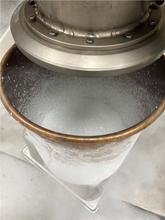Summary
Scientific studies on plastic pollution have been conducted for at least 50 years, and over time these research efforts have increased. Notably, the development of methods for the analysis of microplastic (1 to 1,000 μm) and nanoplastic (1 to 1000 nm) contaminants in the environment has received increased attention, and there is a lack of consistency and standardization among these methods.
Description
Microplastic reference materials of different sizes and shapes are required to support environmental studies. Smaller size classes, particularly between 1 µm and 500 µm, are needed to develop microplastic extraction methods, to identify additives in microplastics, and to create in-house spectral libraries for the identification of plastic composition. NIST is working to expand the current reference material inventory to meet this need (see table below). Consumer goods are a major source of mismanaged waste entering the environment, and additional materials under development include plastic consumer products. High density polyethylene (HDPE) milk jugs, polypropylene (PP) disposable cups, and polystyrene (PS) disposable knives were ground in a large batch cryomill in the NIST Reference Material Production Facility to microplastic sizes (< 5 mm). Sieved size classes are being analyzed by attenuated total reflection Fourier transform infrared spectroscopy (ATR-FTIR), differential scanning calorimetry (DSC), and pyrolysis-gas chromatography/mass spectrometry (py-GC/MS) before the particles are bottled for distribution.

Environmental reference materials with known quantities of microplastics would be useful for validating and standardizing methods to quantify micro- and nanoplastics in the environment. Existing environmental reference materials offered by NIST are typically certified for organic and inorganic chemical pollutants, but until now, the microplastic composition of these materials has not been characterized. Several existing NIST SRMs, such as SRM 1941b Organics in Marine Sediment, SRM 2585 Organic Contaminants in House Dust, SRM 2781 Domestic Sludge, and SRM 2782 Industrial Sludge, will be evaluated for incurred microplastics, and properties of microplastics contained in these SRMs will be characterized.

